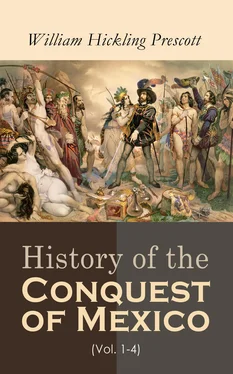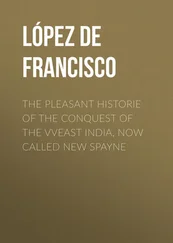The first object of Cortés was to gather tidings of the unfortunate Christians who were reported to be still lingering in captivity on the neighboring continent. From some traders in the island he obtained such a confirmation of the report that he sent Diego de Ordaz with two brigantines to the opposite coast of Yucatan, with instructions to remain there eight days. Some Indians went as messengers in the vessels, who consented to bear a letter to the captives informing them of the arrival of their countrymen in Cozumel with a liberal ransom for their release. Meanwhile the general proposed to make an excursion to the different parts of the island, that he might give employment to the restless spirits of the soldiers, and ascertain the resources of the country.
It was poor and thinly peopled. But everywhere he recognized the vestiges of a higher civilization than what he had before witnessed in the Indian islands. The houses were some of them large, and often built of stone and lime. He was particularly struck with the temples, in which were towers constructed of the same solid materials, and rising several stories in height. In the court of one of these he was amazed by the sight of a cross, of stone and lime, about ten palms high. It was the emblem of the god of rain. Its appearance suggested the wildest conjectures, not merely to the unlettered soldiers, but subsequently to the European scholar, who speculated on the character of the races that had introduced there the sacred symbol of Christianity. But no such inference, as we shall see hereafter, could be warranted. [534]Yet it must be regarded as a curious fact that the Cross should have been venerated as the object of religious worship both in the New World and in regions of the Old where the light of Christianity had never risen. [535]
The next object of Cortés was to reclaim the natives from their gross idolatry and to substitute a purer form of worship. In accomplishing this he was prepared to use force, if milder measures should be ineffectual. There was nothing which the Spanish government had more earnestly at heart than the conversion of the Indians. It forms the constant burden of their instructions, and gave to the military expeditions in this Western hemisphere somewhat of the air of a crusade. The cavalier who embarked in them entered fully into these chivalrous and devotional feelings. No doubt was entertained of the efficacy of conversion, however sudden might be the change or however violent the means. The sword was a good argument, when the tongue failed; and the spread of Mahometanism had shown that seeds sown by the hand of violence, far from perishing in the ground, would spring up and bear fruit to aftertime. If this were so in a bad cause, how much more would it be true in a good one! The Spanish cavalier felt he had a high mission to accomplish as a soldier of the Cross. However unauthorized or unrighteous the war into which he had entered may seem to us, to him it was a holy war. He was in arms against the infidel. Not to care for the soul of his benighted enemy was to put his own in jeopardy. The conversion of a single soul might cover a multitude of sins. It was not for morals that he was concerned, but for the faith . This, though understood in its most literal and limited sense, comprehended the whole scheme of Christian morality. Whoever died in the faith, however immoral had been his life, might be said to die in the Lord. Such was the creed of the Castilian knight of that day, as imbibed from the preachings of the pulpit, from cloisters and colleges at home, from monks and missionaries abroad,—from all save one, whose devotion, kindled at a purer source, was not, alas! permitted to send forth its radiance far into the thick gloom by which he was encompassed. [536]
No one partook more fully of the feelings above described than Hernan Cortés. He was, in truth, the very mirror of the time in which he lived, reflecting its motley characteristics, its speculative devotion and practical license, but with an intensity all his own. He was greatly scandalized at the exhibition of the idolatrous practices of the people of Cozumel, though untainted, as it would seem, with human sacrifices. He endeavored to persuade them to embrace a better faith, through the agency of two ecclesiastics who attended the expedition,—the licentiate Juan Diaz and Father Bartolomé de Olmedo. The latter of these godly men afforded the rare example—rare in any age—of the union of fervent zeal with charity, while he beautifully illustrated in his own conduct the precepts which he taught. He remained with the army through the whole expedition, and by his wise and benevolent counsels was often enabled to mitigate the cruelties of the Conquerors, and to turn aside the edge of the sword from the unfortunate natives.
These two missionaries vainly labored to persuade the people of Cozumel to renounce their abominations, and to allow the Indian idols, in which the Christians recognized the true lineaments of Satan, [537]to be thrown down and demolished. The simple natives, filled with horror at the proposed profanation, exclaimed that these were the gods who sent them the sunshine and the storm, and, should any violence be offered, they would be sure to avenge it by sending their lightnings on the heads of its perpetrators.
Cortés was probably not much of a polemic. At all events, he preferred on the present occasion action to argument, and thought that the best way to convince the Indians of their error was to prove the falsehood of the prediction. He accordingly, without further ceremony, caused the venerated images to be rolled down the stairs of the great temple, amidst the groans and lamentations of the natives. An altar was hastily constructed, an image of the Virgin and Child placed over it, and mass was performed by Father Olmedo and his reverend companion for the first time within the walls of a temple in New Spain. The patient ministers tried once more to pour the light of the gospel into the benighted understandings of the islanders, and to expound the mysteries of the Catholic faith. The Indian interpreter must have afforded rather a dubious channel for the transmission of such abstruse doctrines. But they at length found favor with their auditors, who, whether overawed by the bold bearing of the invaders, or convinced of the impotence of deities that could not shield their own shrines from violation, now consented to embrace Christianity. [538]
While Cortés was thus occupied with the triumphs of the Cross, he received intelligence that Ordaz had returned from Yucatan without tidings of the Spanish captives. Though much chagrined, the general did not choose to postpone longer his departure from Cozumel. The fleet had been well stored with provisions by the friendly inhabitants, and, embarking his troops, Cortés, in the beginning of March, took leave of its hospitable shores. The squadron had not proceeded far, however, before a leak in one of the vessels compelled them to return to the same port. The detention was attended with important consequences; so much so, indeed, that a writer of the time discerns in it “a great mystery and a miracle.” [539]
Soon after landing, a canoe with several Indians was seen making its way from the neighboring shores of Yucatan. On reaching the island, one of the men inquired, in broken Castilian, “if he were among Christians,” and, being answered in the affirmative, threw himself on his knees and returned thanks to Heaven for his delivery. He was one of the unfortunate captives for whose fate so much interest had been felt. His name was Gerónimo de Aguilar, [540]a native of Écija, in Old Spain, where he had been regularly educated for the Church. He had been established with the colony at Darien, and on a voyage from that place to Hispaniola, eight years previous, was wrecked near the coast of Yucatan. He escaped with several of his companions in the ship’s boat, where some perished from hunger and exposure, while others were sacrificed, on their reaching land, by the cannibal natives of the peninsula. Aguilar was preserved from the same dismal fate by escaping into the interior, where he fell into the hands of a powerful cacique, who, though he spared his life, treated him at first with great rigor. The patience of the captive, however, and his singular humility, touched the better feelings of the chieftain, who would have persuaded Aguilar to take a wife among his people, but the ecclesiastic steadily refused, in obedience to his vows. This admirable constancy excited the distrust of the cacique, who put his virtue to a severe test by various temptations, and much of the same sort as those with which the devil is said to have assailed St. Anthony. [541]From all these fiery trials, however, like his ghostly predecessor, he came out unscorched. Continence is too rare and difficult a virtue with barbarians, not to challenge their veneration, and the practice of it has made the reputation of more than one saint in the Old as well as the New World. Aguilar was now intrusted with the care of his master’s household and his numerous wives. He was a man of discretion, as well as virtue; and his counsels were found so salutary that he was consulted on all important matters. In short, Aguilar became a great man among the Indians.
Читать дальше












